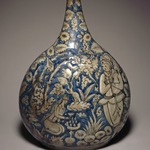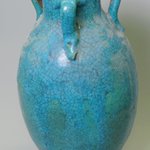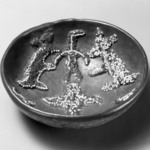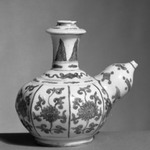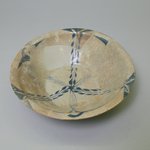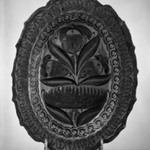

Tile, circa 1700. Ceramic, glaze, 4 3/4 x 4 3/4 x 1/2in. (12.1 x 12.1 x 1.3cm). Brooklyn Museum, Museum Expedition 1942, Frank L. Babbott Fund, 42.235.1. Creative Commons-BY (Photo: Brooklyn Museum, 42.235.1_SL4.jpg)
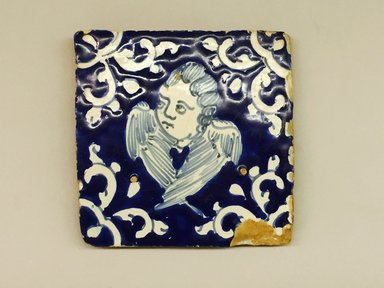
Tile, circa 1700. Ceramic, glaze, 4 3/4 x 4 3/4 x 1/2in. (12.1 x 12.1 x 1.3cm). Brooklyn Museum, Museum Expedition 1942, Frank L. Babbott Fund, 42.235.1. Creative Commons-BY (Photo: Brooklyn Museum, CUR.42.235.1_front.jpg)
Tile
Arts of the Americas
This blue-and-white glazed tile from Puebla, Mexico, features an angel motif, suggesting that it was made for a church or other religious structure. The use of blue-and-white comes from the influence of Chinese porcelain trade goods that moved through Mexico in the eighteenth century, when it was under Spanish rule. Coveted by Europeans as a sign of wealth, blue-and-white porcelain was imitated by Mexican artisans for local use in churches and wealthy homes.
MEDIUM
Ceramic, glaze
DATES
circa 1700
DIMENSIONS
4 3/4 x 4 3/4 x 1/2in. (12.1 x 12.1 x 1.3cm) (show scale)



COLLECTIONS
Arts of the Americas
ACCESSION NUMBER
42.235.1
CREDIT LINE
Museum Expedition 1942, Frank L. Babbott Fund
EXHIBITIONS
MUSEUM LOCATION
This item is not on view
CAPTION
Tile, circa 1700. Ceramic, glaze, 4 3/4 x 4 3/4 x 1/2in. (12.1 x 12.1 x 1.3cm). Brooklyn Museum, Museum Expedition 1942, Frank L. Babbott Fund, 42.235.1. Creative Commons-BY (Photo: Brooklyn Museum, 42.235.1_SL4.jpg)
IMAGE
overall, 42.235.1_SL4.jpg. Brooklyn Museum photograph, 2014
"CUR" at the beginning of an image file name means that the image was created by a curatorial staff member. These study images may be digital point-and-shoot photographs, when we don\'t yet have high-quality studio photography, or they may be scans of older negatives, slides, or photographic prints, providing historical documentation of the object.
RIGHTS STATEMENT
Creative Commons-BY
You may download and use Brooklyn Museum images of this three-dimensional work in accordance with a Creative Commons license. Fair use, as understood under the United States Copyright Act, may also apply.
Please include caption information from this page and credit the Brooklyn Museum. If you need a high resolution file, please fill out our online application form (charges apply).
For further information about copyright, we recommend resources at the United States Library of Congress, Cornell University, Copyright and Cultural Institutions: Guidelines for U.S. Libraries, Archives, and Museums, and Copyright Watch.
For more information about the Museum's rights project, including how rights types are assigned, please see our blog posts on copyright.
If you have any information regarding this work and rights to it, please contact copyright@brooklynmuseum.org.
RECORD COMPLETENESS
Not every record you will find here is complete. More information is available for some works than for others, and some entries have been updated more recently. Records are frequently reviewed and revised, and we welcome any additional information you might have.






